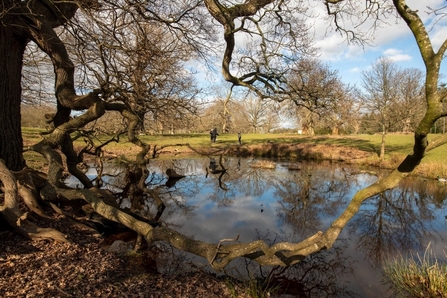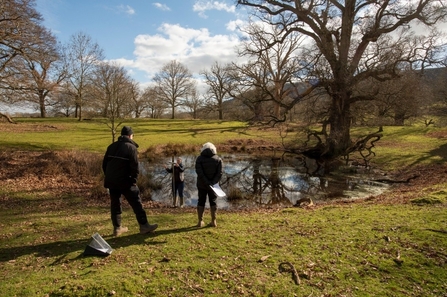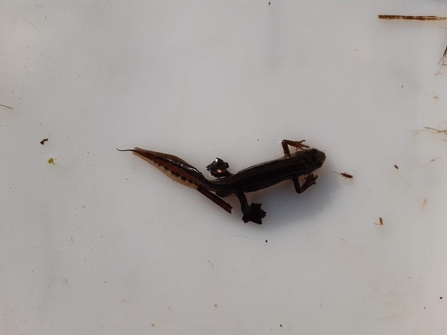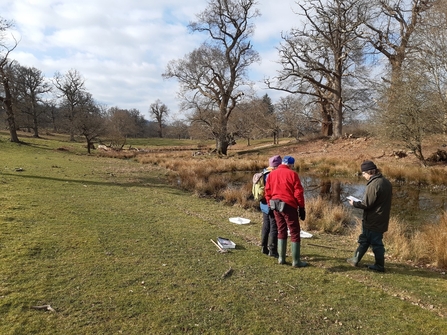Finally, the days are lengthening, and the weather is warming up! As the plants start to grow and wildlife wakes up it is nearly survey season for the Ice Age Ponds team. The 2020 survey season didn’t really get started before the Covid-19 restrictions hit, so this year we have even more to do and wanted to get a head start by getting volunteers trained up nice and early.
Ice Age Ponds Blog: Practical volunteer training weekend March 2021

Moccas Park round pool (c) Will Watson
So, on the weekend of March 6th and 7th we headed out to the beautiful Moccas park. After a glorious warm weekend just the week before, it was typical that temperatures plummeted and on Sunday we even had to break the ice before pond dipping! Luckily the sun came out to warm us up and the incredible setting more than made up for the temperature. Set in a parkland and surrounded by veteran trees, some possibly 900 years old, Moccas Park provided the perfect training ground with two easy to survey Ice Age Ponds within a few metres of one another. Over the two days we had more than fifteen volunteers brave the cold to be trained either individually or within their household bubbles.

Geological survey training with Beth Andrews at Round Pool (c) Will Watson
Volunteers engaged in two forty-five minute training sessions, first with our project officer and geologist Beth Andrews to learn how to survey the physical features of the pond. This includes taking Ph and nitrate measurements from the water and practicing pacing out the size of the pond. (Watching people with short legs pacing can provide extra entertainment as they try to make their strides one metre long, including myself!). Then they moved on to a session with one of our project ecologists, Will Watson and Giles King-Salter, to learn more about the ecological side of the surveys.

Palmate newt found by Giles in Linear Pool
All the volunteers were particularly excited to do some pond dipping, it seems no matter what age you are, you can still get excited by looking at all the creepy crawlies inside ponds. Despite the cold the ponds did seem to be coming to life. There were clumps of frogspawn in the middle and we even found a couple of adult Palmate newts and some Great Crested newt eggs. I was fascinated to learn the care that newts take to lay each individual egg on a different leaf before folding the leaf over to protect the egg. A bit different to the mass of eggs that frogs and toads lay! On the Saturday the training took place to a backdrop of a croaking frogs chorus, which come Sunday was drowned out by an influx of Canada Geese gathering on the largest pond, Lawn Pool.

Ecological training with Giles King-Salter
So, what happens next? Well, following their training we will be sending volunteers out around north-western Herefordshire to survey a range of Ice Age Ponds. The data they collect will help us to identify the key features of these ponds, how valuable they are to wildlife and the impacts that their surrounding areas have on the water quality and life in the ponds. We hope that this data will help to inform future management plans for Ice Age ponds and help the public to understand the vital resource that these ponds are.
This project is funded by the National Lottery Heritage Fund and wouldn’t be possible without the players of the National Lottery.


A mass of frogspawn found by Giles in Linear Pool

